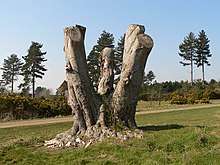Living stump
A living stump is created when a live tree is cut, burned, eaten, or infected, causing its cambium to die above the root system. Stumps are generally characterized as having a thin outer layer of living cells that surround a hollow central cavity. [1] Living stumps can survive for several years by root grafting to the root system of living trees and using excess carbon reserves. Root grafting allows for carbon transfer from living trees to living stumps resulting in incremental cambium growth in the stump. [2] Stumps can grow a callus tissue over its cross section which prolongs longevity of the stump by protecting it from infection and insect damage. [3] A living stump which is capable of producing sprouts or cuttings is known as a stool, and is used in the coppicing method of woodland management.[4]

Common Examples
- Pinus strobus (white pine)
- Castanea dentata (American chestnut)
- Tsuga spp. (hemlock)
- Pseudotsuga menziesii (Douglas fir)
- Cedrus spp. (cedar)
References
- Davidson, Donald W. (1963). "Living Stumps of Tsuga canadensis (L.) Carr. (Hemlock) in Northern New Jersey". Bulletin of the Torrey Botanical Club. 90: 204–207. doi:10.2307/2482756.
- Bormann, F.H.; Graham Jr., B.F. "The occurrence of natural root grafting in eastern white pine (Pinus strobus L.), and its ecological implications". Ecology. 40: 677–691. doi:10.2307/1929820.
- Lanner, Ronald M. (1961). "Living Stumps in the Sierra Nevada". Ecology. 42: 170–173. doi:10.2307/1933281.
- Crist, John B.; Mattson, James A.; Winsauer, Sharon A. 1983. Effect of severing method and stump height on coppice growth. In: Hansen, Edward A., ed. Intensive plantation culture: 12 years research. Gen. Tech. Rep. NC-91. St. Paul, MN: U.S. Department of Agriculture, Forest Service, North Central Forest Experiment Station: 58-6; retrieved on 2008-05-10 from www.treesearch.fs.fed.us/pubs/18839.
| Wikimedia Commons has media related to Tree stumps. |